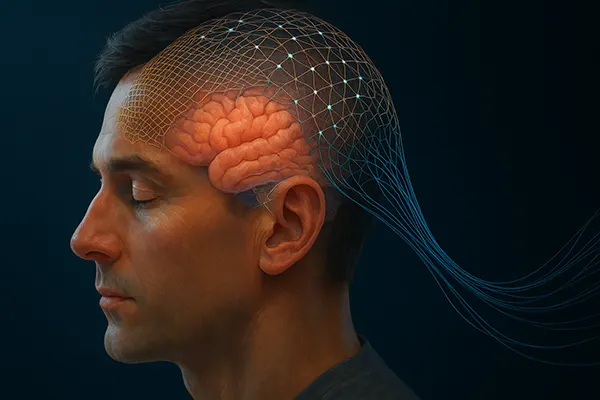Neurotechnology has taken a significant step forward with the development of neural lace — microscopic bionic sensors designed to create seamless interaction between the human brain and external devices. Unlike earlier, bulky implants, these ultrathin meshes and nanowire-based systems promise a new era of brain-machine communication, offering opportunities in medicine, rehabilitation, and even everyday human-computer interaction. By 2025, research teams worldwide are advancing prototypes that combine biocompatibility, durability, and real-time data transfer, bringing us closer to practical applications.
Scientific Principles Behind Neural Lace
The foundation of neural lace lies in nanoscale engineering. These devices are created from flexible and porous materials that can integrate with neural tissue without causing significant inflammation or scarring. Unlike rigid electrodes, neural lace can adapt to the brain’s soft texture, minimising rejection and ensuring more stable long-term functionality. This makes them ideal for collecting precise neural signals or stimulating specific brain regions.
Researchers at institutions such as Harvard, MIT, and the University of California have developed early models using conductive polymers and biocompatible metals like gold and platinum. These structures allow thousands of sensors to map brain activity with remarkable accuracy. In addition, neural lace can transmit data wirelessly, removing the need for invasive cables or large external devices.
The ultimate scientific challenge remains energy efficiency and durability. Current efforts are focused on powering these sensors using bioelectric signals or inductive charging, ensuring continuous operation without invasive maintenance. As these issues are resolved, neural lace will become a viable option for clinical use and consumer applications.
Technological Development and Innovations
In the past five years, breakthroughs in nanofabrication have enabled researchers to create neural lace meshes that are thinner than a human hair but strong enough to survive surgical implantation. These innovations make it possible to cover larger brain regions with high-resolution monitoring while reducing the risks of tissue damage. Some versions even dissolve harmlessly after their task is complete, providing temporary monitoring solutions.
Wireless technology is another area of rapid progress. Modern prototypes can transmit brain activity data in real time to external devices, enabling applications from prosthetic limb control to neurorehabilitation after strokes. Moreover, machine learning models trained on these signals can interpret complex brain patterns, translating thought into action with increasing accuracy.
By 2025, partnerships between universities and companies specialising in medical devices have begun clinical trials on patients with paralysis and severe neurological conditions. These tests demonstrate promising results in restoring partial mobility and enabling communication for individuals who previously relied on assistive technologies.
Applications in Medicine and Human Enhancement
The medical potential of neural lace is enormous. Patients suffering from neurodegenerative disorders such as Parkinson’s and Alzheimer’s could benefit from continuous monitoring and targeted stimulation of affected brain regions. This offers the possibility of slowing disease progression or alleviating symptoms without the side effects associated with drug treatments.
For individuals with spinal cord injuries or motor neuron diseases, neural lace provides a pathway to regain movement. By directly connecting brain signals to prosthetics or exoskeletons, users can control devices naturally, restoring independence and quality of life. Rehabilitation centres in the United States, Europe, and Asia are already testing such systems in pilot programmes.
Beyond medicine, the technology has potential in human enhancement. Neural lace could eventually allow people to interact directly with computers, virtual environments, or even share sensory experiences. Ethical debates continue over how far such applications should go, but the technological foundation is being built today.
Ethical Challenges and Safety Concerns
The introduction of neural lace raises critical ethical questions. One concern is privacy: if brain activity can be read and transmitted, who controls this information, and how can misuse be prevented? Governments and research institutions are working on establishing strict regulations to safeguard user rights and prevent exploitation.
Safety is another challenge. Although materials have become more biocompatible, long-term effects of foreign structures inside the brain are still under investigation. Researchers must ensure that implants do not degrade or release harmful substances over time, particularly in younger patients who may rely on them for decades.
There are also social implications. The potential for human enhancement could create inequality if only certain groups gain access to advanced cognitive or physical abilities. Addressing these issues requires international cooperation and ethical frameworks to ensure that neural lace benefits humanity as a whole rather than deepening divides.

The Future of Brain-Machine Interaction
Looking ahead, neural lace could redefine how humans interact with technology. Instead of relying on external devices like keyboards, screens, or even voice commands, future systems may allow thought-driven interfaces. This would transform industries ranging from healthcare to education, entertainment, and beyond.
One area of interest is collaborative intelligence. Neural lace could enable groups of people to connect directly through shared neural patterns, opening possibilities for collective problem-solving and creative collaboration. While such ideas remain speculative, the pace of progress suggests they may not be far off.
By 2030, experts predict that neural lace may transition from laboratory experiments to regulated medical treatments and eventually consumer-grade products. Achieving this requires not only technological innovation but also careful consideration of ethical, legal, and societal impacts to ensure safe and equitable adoption.
Global Research and Market Outlook
Investment in brain-machine interface research has increased significantly since 2020, with governments, universities, and private companies recognising its transformative potential. The global neurotechnology market is expected to surpass £25 billion by 2030, with neural lace technologies contributing a substantial share. Leading organisations such as Neuralink, Kernel, and Synchron are already competing for patents and clinical trials.
Asia and Europe are also expanding their efforts, with research centres in Japan, Germany, and Switzerland producing some of the most advanced prototypes. This international collaboration ensures that innovation is not confined to a single region but shared across the scientific community.
The outlook remains cautiously optimistic. While technological hurdles remain, the combination of scientific progress, growing investment, and increasing clinical demand makes it likely that neural lace will become one of the defining technologies of the 21st century. If applied responsibly, it could revolutionise medicine, communication, and human potential itself.



